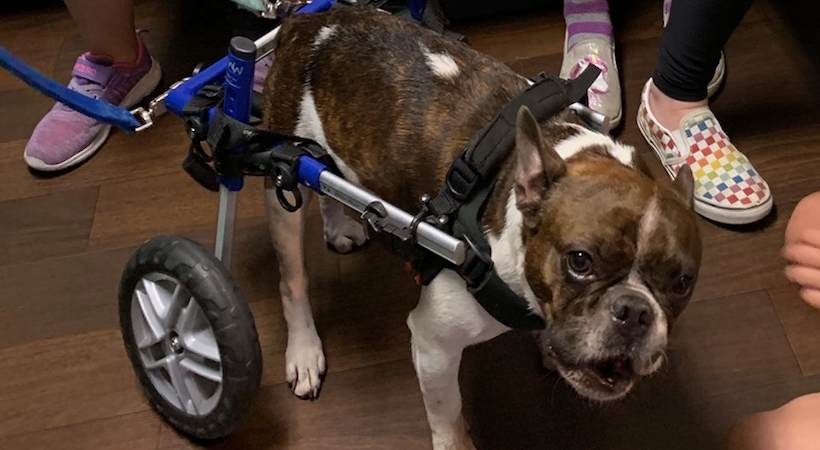So your Frenchie is running and playing around when it suddenly starts limping. This situation can be due to different reasons, but one thing is for sure: your dog needs immediate vet care. A French Bulldog limping back leg can be anything from a minor sprain, insect bite, fracture, arthritis, or the dreaded hip dysplasia.
French Bulldogs love playing and exploring around. This outgoing nature makes them susceptible to various injuries, which can hurt their rear legs. Take note that such injuries can be minor or severe. If your Frenchie suddenly went by with a limping back leg, you should check for the possible causes below.
French Bulldog Limping Back Leg Reasons
1. Sprain

One of the most common reasons behind a dog’s limping is a sprain. This can happen when a French Bulldog zooms in too fast and pulls a muscle on its rear legs.
Despite a Frenchie’s enthusiasm, their bodies aren’t made for athleticism. They have deep chests and short legs that can get sprained easily. So when they overdo roughhousing, they stand the chance of having sprained legs.
A Frenchie that suffers from a rear leg sprain will limp and cry because of the pain. Most cases of leg sprain in dogs will go away on their own after some rest. A day or two should be enough for your Frenchie to heal its hurt leg.
But if your Frenchie is crying out of pain, you should bring it to the vet. Your dog may need painkillers or a series of treatments to soothe the sprained muscles.
If your dog suffered from a massive sprain, the vet might need to place a splint on the affected leg. A surgical procedure might be required on rare occasions if your dog suffered from a cranial cruciate ligament (CCL) tear. This is the canine counterpart of an ACL tear in humans. And yes, it’s unbearably painful.
2. Insect stings

If your French Bulldog is playing outdoors before limping, you should check for insect bites. Bee and wasp stings are very common since dogs love chasing and playing after them. The bitten leg will get swollen and painful, and your dog may need an emergency trip to the vet.
Most of the time, bee stings are harmless. However, some dogs may suffer from a severe allergic reaction (anaphylaxis), especially if they received multiple bites at once.
If you suspect that your Frenchie has been stung by a bee, you should look for the stinger immediately. A bee leaves its stinger on its victim, which continues to release venom.
Don’t use tweezers in removing the stinger because this will squeeze out the remaining venom. Instead, use a credit card to flick it out of your dog’s skin.
Once you’ve removed the stinger, apply an ice pack on the affected leg of your French Bulldog. You should also prepare a baking soda and water paste as first aid to the bite spot. This will soothe the pain and irritation. But if your Frenchie got multiple bites, you should give it an oatmeal bath instead.
I suggest putting your dog in an Elizabethan collar to prevent scratching and licking of the affected leg.
3. Injured paw

An injured paw will also cause your French Bulldog to limp its back leg. Your dog probably stepped on a sharp object, which injured its paw pad. A cracked and dry paw can also cause limping.
A quick check on your dog’s paws will reveal a lot. If there are bleeding and cuts, you should disinfect and treat them right away. You can bandage the paw and put your dog on a cone to speed up the healing.
Remember that your dog’s paws are very vulnerable to injuries. Unlike us, dogs don’t naturally wear shoes. Still, you can give your Frenchie an added layer of protection by putting on a set of dog boots on its paws. This protects your dog’s paws from the hot pavement as well as sharp objects that may hurt its feet.
Also, I recommend using paw wax to keep your dog’s paws moisturized. This will prevent painful cracking that can lead to limping.
However, if your dog is chewing and licking the limping leg, you should look closely. Your Frenchie might be dealing with a paw infection, which is very itchy, swollen, and uncomfortable. This requires immediate treatment to prevent it from worsening.
4. Hip dysplasia

One of the major orthopedic problems observed on French Bulldogs is hip dysplasia. Deep-chested canines like English Bulldogs, French Bulldogs, and Pit Bulls are at high risk of having this condition. Large breeds are also prone to this condition.
Take note that hip dysplasia is a genetic condition. If your Frenchie came from a responsible breeder, it’s unlikely to have this problem.
Hip dysplasia occurs when the ball and socket structure of the hip didn’t grow properly. What happens is that the joint moves roughly instead of sliding smoothly. This results in great pain, which will cause limping and wasting of the rear leg muscles.
French Bulldogs with hip dysplasia will bunny hop and limp on their rear legs. You’ll also notice lameness on its extremities as well as decreased physical activity.
If you suspect that your dog has hip dysplasia, you should bring it to the vet right away. Your French Bulldog will undergo X-rays to check its hips.
Depending on the severity of the hip dysplasia, the vet will explore various treatment options. In some cases, the dog’s condition doesn’t need intensive treatment, only management of the pain.
However, some canines with hip dysplasia may undergo pelvic osteotomy in an effort to correct the defect. Take note that these surgical procedures don’t guarantee a 100% fix. It’s aimed to reduce the severity of the dysplasia and the pain your pet is feeling.
5. Arthritis

For older French Bulldogs, arthritis is a common occurrence. Like humans, your dog’s joints will suffer from wear and tear. This will thin the cartilage that cushions the joint. When the cartilage this, the joints will then rub roughly, which causes inflammation and limping on the affected leg.
French Bulldogs with arthritis will exhibit lameness on the affected joint. Your pooch will also move slower than normal, which is very easy to notice for an eager breed like Frenchies.
Take note that once your dog is diagnosed with arthritis, it would be a lifetime of managing the condition. There’s no absolute treatment for arthritis, only ways to deal with the pain and discomfort.
First, you need to add glucosamine and chondroitin to your Frenchie’s diet. These substances boost chondrocyte cell production. This cell is responsible for keeping cartilage healthy and strong. While it will not regenerate your dog’s joint cartilage, supplementation will delay its degradation.
Also, you’ll need to limit your dog’s physical activities. It’s no longer advisable for the Frenchie to run around freely and should also prevent your dog from jumping from elevated surfaces. Anything that will put intense pressure on your dog’s joints should be avoided.
6. Degenerative myelopathy

Degenerative myelopathy is a progressive condition that’s commonly diagnosed in older dogs. What happens is that the dog loses its muscle coordination on the hind limbs. Its initial onset may seem like your French Bulldog is limping.
There are three stages of degenerative myelopathy: early, mid, and late stages. Your dog’s muscle loss will become worse until it can no longer bear the weight of its body. French Bulldogs with late-stage degenerative myelopathy can no longer stand up and will suffer from incontinence.
The only consolation here is that dogs with degenerative myelopathy don’t feel pain. However, it progresses quite quickly. On average, a dog with this condition will transition from early to late stages in a span of 6 months to a year. The last stage would be your dog being paraplegic.
Dogs with degenerative myelopathy can still survive. They will be fitted with a dog wheelchair, so the pooches can still get up and walk on their own.
The sad truth is that many dogs with this condition are euthanized since there’s no cure, and the prognosis is often downhill. Depending on how the degenerative myelopathy impacts your Frenchie’s life, the vet will recommend whether it’s best to put the dog to sleep or not.
7. Fractures and dislocations

Lastly, the culprit behind your Frenchie’s limping could be fractures or dislocations of the joints. Due to the body structure of French Bulldogs, they can easily break parts of their legs.
A fracture can happen if your dog fell from an elevated surface or overexerted its rear legs. Take note that such fractures would be excruciatingly painful, and the limping is just the tip of the iceberg.
Dogs with fractured legs need to be brought to the vet’s clinic immediately. Your Frenchie’s affected leg will be put on a splint to keep the joints and bones from moving. In some cases, the affected leg will be placed in a cast to promote healing. And in worst conditions, your dog will need to undergo a surgical operation where metal plates will be used to restore the bone structure.
Recovery from a major leg fracture will take time. It can take weeks to months for your French Bulldog to be back on its feet. The vet will also recommend painkillers to manage the discomfort the fracture brings.
During the recovery process, it’s important to limit your dog’s physical activities as well as access to the treated leg. Also, you should lift and carry your dog if it needs to go potty or move to a specific area in the house.
Frequently Asked Questions
Q: Should I walk my dog if he’s limping?
A: No, the fact that your dog is limping means it might be in pain. Walking the pooch will just add up to the suffering and potentially make the situation worse. Instead, you should bring your dog to the vet for proper examination and treatment. After that, let the dog rest and recover before taking it on regular walks.
Q: Will a dog cry if its leg is broken?
A: Dogs will usually cry when in pain or discomfort. Your French Bulldog will surely exhibit signs of a broken leg by whining, crying, and being reluctant to move. A quick check on the affected leg will give you an idea if your dog is injured or in pain. For a broken leg, the vet’s clinic is the best place to go.
Q: Why is my dog limping on and off?
A: Some dogs will limp when their paws are hurt mildly. After some time, the dog will recover, and the limping will stop. However, if the pooch hurts its leg or paw again, the limping will recur. You should also consider the possibility of hip dysplasia or degenerative myelopathy, which can manifest as limping in its initial stages.
Q: Can I give ibuprofen to my dog to ease the pain of his back leg?
A: No! You should never self-administer ibuprofen to your French Bulldog. Doing so will cause more health problems. Dogs can easily succumb to ibuprofen toxicity, which can lead to bleeding stomach ulcers and other life-threatening symptoms. In the end, your effort to treat your dog will backfire.
Q: Can a tick cause a dog to limp?
A: While very rare, some dogs can suffer from a condition called ‘tick paralysis’. This is caused by a female tick carrying a neurotoxin on its saliva. The infected dog will become paralyzed on its lower extremities, which may appear as limping in the early stages.
Final words
If you’re seeing a French Bulldog limping back leg, you should bring the dog to the vet right away. This is to diagnose the problem, especially if the limping isn’t going away. You should also perform a quick check of your dog’s hind legs to see if it has injuries or other problems you can mention to the veterinarian.
As much as possible, avoid self-medicating your dog when it comes to serious leg problems. The vet is still the best person to consult.

